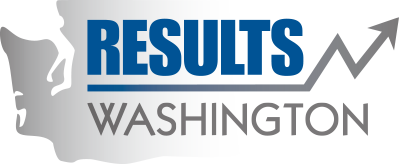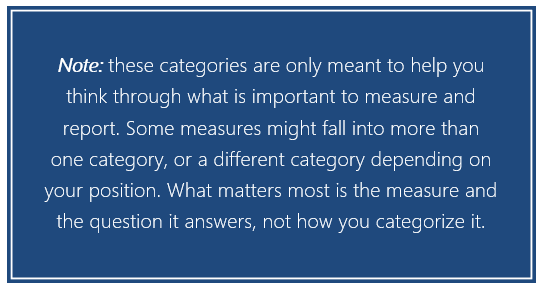How do we decide what to measure?
There are almost infinite possibilities for agencies to measure, and always with limited resources. With that in mind, each agency should have a diverse set of measures that provides a good overview of its work and the challenges it is addressing. Agencies should have several different types of measures for different purposes.
- Indicators, or community conditions, are signs of the overall wellbeing of the communities and populations we serve. These are generally the closest we’ll ever get to measuring the outcomes we actually want to achieve. They can help us set priorities going forward by identifying either positive or negative trends and/or areas where needs or disparities aren’t being addressed. Indicators reflect impacts that are influenced by the work of many agencies and factors. Therefore, the work of any one agency, or even group of agencies, can’t fully control the trend, but are critical to facilitating conversations across state and local governments, private partners and communities. Indicators help keep efforts focused on our shared goals, rather than the intermediate steps we take to reach them
- Examples: student standardized test scores; area of eelgrass beds in Puget Sound; Washington interest rates.
- Operational measures relate to our ongoing core programs and services. They can help identify trends so that we can quickly respond to changing circumstances like an increase in demand, or a bottleneck in our processes. These measures will tell your leadership when a budget request might be needed will help you communicate that need to the Office of Financial Management and other decision makers. These measures are most helpful when we track them over long periods of time so that trends can be recognized.
- How much are we doing? Operational measures might track the demand for our services and how much we are providing. How many people do we serve?
- Examples: the number of applications processed; the number of calls answered; the amount of food distributed.
- How well are we doing? Operational measures might track the quality or efficiency of our services, or our role as an employer, purchaser, or member of the community.
- Examples: The percentage of issues resolved on the first customer call; the percentage of applications processed within the promised window of time; the rate of employee engagement; the disparity in our rate of contracting with women-owned businesses.
- Is anyone better off? Operational measures might track the impact our programs or services have on the people we serve.
- Examples: The percentage of participants who were still employed 12 months after a program ended; the infant mortality rate in families who received a service.
- How much are we doing? Operational measures might track the demand for our services and how much we are providing. How many people do we serve?
- Strategic measures show our progress on strategic changes to the way we do our work. They are likely to have shorter timelines than operational measures. They can often be paired with operational measures to show what we are trying to change and how. An operational measure can also be a strategic measure while its improvement is part of an agency’s strategic plan.
- Examples: the number of community partners that have implemented our new initiative; the initiative was implemented by the expected deadline; the initiative did what it intended and moved the desired measures or impacted the outcomes it aimed to move.
- Examples: the number of community partners that have implemented our new initiative; the initiative was implemented by the expected deadline; the initiative did what it intended and moved the desired measures or impacted the outcomes it aimed to move.
If an agency reported only measures that answered the question “is anyone better off?,” the data might show the effectiveness of the program but might leave unanswered questions about next steps if the results didn’t meet expectations. If an agency reported only measures that answered the question “how much are we doing?,” audiences would have no way to know if all that hard work was having an impact.



 previous
previous